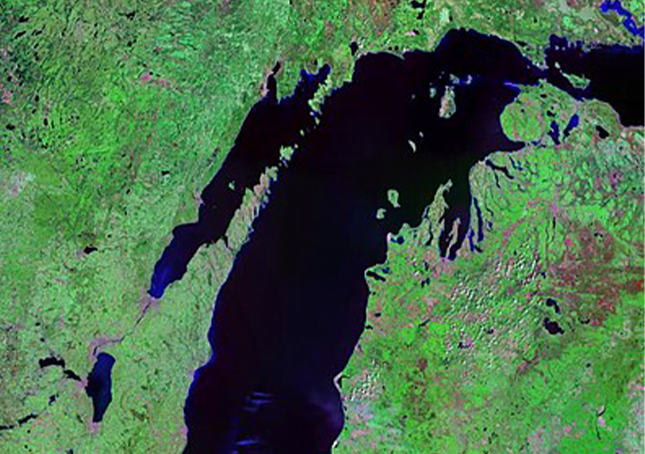Lake Michigan

Lake Michigan is one of the five Great Lakes of North America. It is the second-largest of the Great Lakes by volume[5] (1,180 cu mi (4,900 km3)) and the third-largest by surface area (22,404 sq mi (58,030 km2)), after Lake Superior and Lake Huron. To the east, its basin is conjoined with that of Lake Huron through the narrow Straits of Mackinac, giving it the same surface elevation as its easterly counterpart; the two are technically a single lake.
Lake Michigan is the largest lake by area in one country. Located in the United States, it is shared, from west to east, by the states of Wisconsin, Illinois, Indiana, and Michigan. Ports along its shores include Milwaukee and the City of Green Bay in Wisconsin; Chicago in Illinois; Gary in Indiana; and Muskegon in Michigan. Green Bay is a large bay in its northwest, and Grand Traverse Bay is in the northeast. The word “Michigan” is believed to come from the Ojibwe word michi-gami meaning “great water”.
Some of the earliest human inhabitants of the Lake Michigan region were the Hopewell Native Americans. Their culture declined after 800 AD, and for the next few hundred years, the region was the home of peoples known as the Late Woodland Native Americans.
In the early 17th century, when western European explorers made their first forays into the region, they encountered descendants of the Late Woodland Native Americans: the historic Chippewa; Menominee; Sauk; Fox; Winnebago; Miami; Ottawa; and Potawatomi peoples. The French explorer Jean Nicolet is believed to have been the first European to reach Lake Michigan, possibly in 1634 or 1638.[11] In the earliest European maps of the region, the name of Lake Illinois has been found in addition to that of “Michigan”, named for the Illinois Confederation of tribes.
Lake Michigan is joined via the narrow, open-water Straits of Mackinac with Lake Huron, and the combined body of water is sometimes called Michigan–Huron (also Huron–Michigan). The Straits of Mackinac were an important Native American and fur trade route. Located on the southern side of the straits is the town of Mackinaw City, Michigan, the site of Fort Michilimackinac, a reconstructed French fort founded in 1715, and on the northern side is St. Ignace, Michigan, site of a French Catholic mission to the Indians, founded in 1671.
In 1673, Jacques Marquette, Louis Jolliet and their crew of five Métis voyageurs followed Lake Michigan to Green Bay and up the Fox River, nearly to its headwaters, in their search for the Mississippi River. By the late 18th century, the eastern end of the straits was controlled by Fort Mackinac on Mackinac Island, a British colonial and early American military base and fur trade center, founded in 1781.[13]
With the advent of European exploration into the area in the late 17th century, Lake Michigan became used as part of a line of waterways leading from the Saint Lawrence River to the Mississippi River and thence to the Gulf of Mexico.[14] French coureurs des bois and voyageurs established small ports and trading communities, such as Green Bay, on the lake during the late 17th and early 18th centuries.[15] In the 19th century, Lake Michigan was integral to the development of Chicago and the Midwestern United States west of the lake. For example, 90% of the grain shipped from Chicago travelled by ships east over Lake Michigan during the antebellum years. The volume rarely fell below 50% after the Civil War even with the major expansion of railroad shipping.
The first person to reach the deep bottom of Lake Michigan was J. Val Klump, a scientist at the University of Wisconsin–Milwaukee in 1985. Klump reached the bottom via submersible as part of a research expedition.[17] In 2007, a row of stones paralleling an ancient shoreline was discovered by Mark Holley, professor of underwater archeology at Northwestern Michigan College. This formation lies 40 feet (12 m) below the surface of the lake. One of the stones is said to have a carving resembling a mastodon. The formation needed more study before it could be authenticated.[18][19] The warming of Lake Michigan was the subject of a 2018 report by Purdue University. In each decade since 1980, steady increases in obscure surface temperature have occurred. This is likely to lead to decreasing native habitat and to adversely affect native species survival, including game fish.
